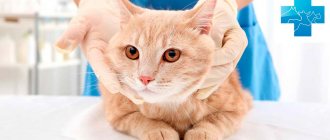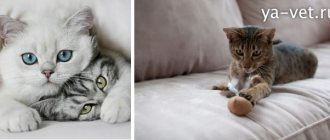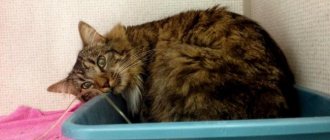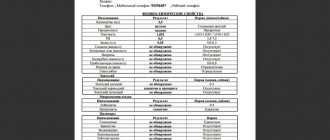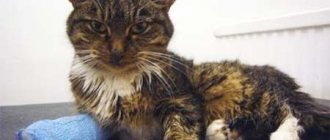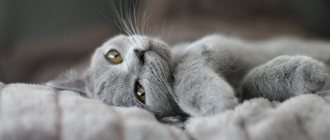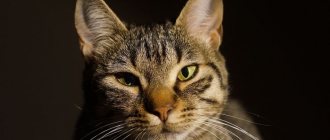Pathologies in the field of the cardiovascular system in domestic cats are observed in almost 10% of pets that are examined by a veterinarian. As a rule, heart diseases are diagnosed in advanced forms due to the fact that symptoms appear late. Over time, myocardial diseases do not fade away, like most infectious pathologies, but gain momentum, causing serious disorders and complications, including death.
Most heart diseases in cats occur in a latent form without obvious symptoms. This is due to the fact that the myocardium is well protected by the chest and it is difficult to identify disorders with the naked eye during a simple clinical examination.
General information about the heart as an organ and the mechanism of its work
Like most mammals, the cat's heart is the main link in the general blood flow system. This muscle, which has a cavity inside, is located in the chest area. The myocardium is a kind of pump for pumping blood throughout the body and saturating each cell with all the useful elements.
At the initial stages, blood penetrates into the right half of the myocardium, and then through the pulmonary artery it is pumped to the pulmonary structures and saturates the cells with oxygen. Next, oxygenated blood enters the left half, which pumps blood into the aorta and spreads throughout the body. The right and left sides of the myocardium have upper chambers called atria and lower chambers called ventricles.
The structural element of the myocardium is two main valves - tricuspid and mitral. They are necessary to prevent the return of blood to the atrium from the ventricles during contraction. The muscle fibers of the ventricles are connected to the valves using specific tendons that prevent them from being pushed towards the atria.
The heart muscle is an important component of the animal’s body. The function of the heart is to pump blood, rich in essential oxygen and other nutrients, through large and small vessels to all cells of the body. Pathologies in the myocardium are based on a decrease in the efficiency of the blood pumping process. As a result, this leads to a large accumulation of fluid in the sternum and abdominal area.
In veterinary medicine, there are two types of heart diseases - one type involves damage to the heart valve itself, and the second affects the myocardium itself. In both the first and second cases, pathologies can be dealt with by establishing proper nutrition and dosed exercise.
In the case of severe cardiac pathologies, it is necessary to regularly check with veterinary specialists and, if necessary, give the animal medications prescribed by a doctor. Regular consultations at a veterinary clinic and a properly selected diet can normalize the cat’s condition and allow the animal to live a normal life.
Heartworm (dirofilariasis)
Heartworm or dirofilariasis is a fairly common parasitic disease today. Previously, it was believed that this disease was a disease of more southern regions, but statistics have changed greatly in recent years, and dirofilariasis began to be recorded in Moscow and the region, and even St. Petersburg.
Symptoms can be hidden or obvious. With obvious symptoms, the pet owner will observe a picture of heart failure:
- fast fatiguability;
- dyspnea;
- pallor of the mucous membranes.
Dirofilariasis is transmitted from mosquitoes to animals and people. Dirofilariae live, multiply and circulate constantly in the bloodstream, heart, subcutaneous tissue and muscles. These are viviparous organisms; their larvae, stage 1 microfilariae, can circulate in the blood of an infected dog for up to 2.5 years without causing any symptoms. If such a dog is bitten by a mosquito, the larva in it goes through the following stages of development in 2-3 weeks and becomes invasive, that is, capable of infecting the next organism. When bitten by an infected mosquito, the infective larvae enter the dog's subcutaneous tissue, where they mature further. The larvae of the 5th stage penetrate the blood vessels, are carried by the blood flow into the heart and large vessels, and after 6 months they become adult, sexually mature helminths and can reach 35 cm in length, causing harm to organs and tissues. The danger of this disease lies in thromboembolism by adult helminths in the heart and instant death of the animal.
Mechanism of disease development
There are several types of pathologies in the heart area. The first type is valve disease, characterized by a decrease in the amount of blood entering the body due to blood leaking through the valve itself. The second type of pathology is myocardial diseases, characterized by a general weakening or thickening of the heart muscle, which results in a decrease in the efficiency of blood pumping.
There is no single common cause for the development of heart pathologies. But problems with diet are more likely to lead to cardiovascular disease. In addition, the mechanism for the development of heart disease is based on the general physical condition of the animal. Thus, cats that are overweight are more often susceptible to pathological conditions of the myocardium.
The age of the pet plays an important role, because the older the pet, the higher the likelihood of developing cardiomyopathies. Some cat breeds, such as American Shorthairs, Maine Coons and Persians, have a genetic predisposition to developing heart disease.
Which pets are more likely to have heart problems?
In most cases, myocardial problems appear with age. In dwarf and small dogs, the valves often become thickened and deformed. Yorkshire terriers, chihuahuas, dachshunds, toy terriers, and Pekingese are at risk.
Large and giant dog breeds, as well as cocker spaniels, are prone to dilated cardiomyopathy. The disease is characterized by expansion of all chambers of the heart, impaired ability to contract, rapid development of arrhythmia, and heart failure.
Dilated cardiomyopathy also occurs in cats, but more often – hypertrophic cardiomyopathy (65% of cases). With this pathology, the walls of the myocardium thicken completely or partially, and the ventricular cavity decreases. The problem often occurs in Maine Coons, Ragdolls, Sphinxes, British Shorthairs, and Scottish Folds.
Most Common Heart Diseases in Cats
Any deviations in the functioning of the myocardium and its structural features are considered to be diseases. Pathologies can be triggered by stress, birth defects, serious herbs and helminthiases. Myocardial pathologies are divided depending on their symptoms. Thus, the following diseases are distinguished:
- depending on the origin, there are congenital and acquired diseases;
- depending on the cause of the disorders, there may be infectious and degenerative diseases;
- depending on duration and clinical status (for example, right and left ventricular failure).
Heart failure in domestic cats is not an independent pathology. Heart failure refers to abnormalities that cause the inability of the myocardium to pump the required amount of blood throughout the body to meet needs. Blood flow to all body tissues is reduced as a result of stagnation or increased fluid accumulation. A constant lack of blood to the organs provokes serious pathological changes throughout the body. The following pathological processes in a cat’s body can provoke heart disease:
- pathologies of the valve system – valves do not close or open in a timely manner;
- myocardial pathology – weak compression or incomplete relaxation of the heart muscle;
- cardiac arrhythmia – too rapid heartbeat (observed after anesthesia);
- vascular diseases - lead to great interference in the blood flow and, accordingly, provoke problems in the functioning of the whole body;
- the presence of cardiac shunts (breed predisposition) is characterized by the presence of holes in the chambers of the heart on the left or right;
- damage to the myocardium by parasites (dirofilariasis).
Symptoms of heart disease are based on problems with blood flow. Lack of blood flow to the organs due to exercise intolerance leads to fainting and weakness. When blood is retained in the organs, swelling occurs, the breathing process is disrupted (shortness of breath), the color of the visible mucous membranes changes and becomes cyanotic.
Stress-induced feline cardiomyopathy
This form of cardiomyopathy develops in completely healthy cats after exposure to a stress factor. Most often this occurs within 1-30 days after planned surgical interventions (castration and sterilization). The disease is characterized by temporary thickening of the myocardium of the left ventricle, probably due to inflammation of the heart muscle, the relaxation processes of the heart are disrupted, which leads to the fact that the left ventricle is not able to pump out all the blood from the pulmonary circulation. The pressure in the pulmonary veins and left atrium increases and congestive heart failure develops, which manifests itself in the form of pulmonary edema or hydrothorax.
General trend in the treatment of heart diseases
If you notice characteristic signs of myocardial dysfunction in your pet, it is recommended to contact a veterinary clinic as soon as possible. It is imperative to diagnose the animal's condition. The following studies are prescribed:
- a general history taking, based on visible signs from the moment they appear;
- assessment of the general condition of the cat - with congestion in the myocardium, the appearance of the animal changes;
- physical examinations - auscultation and percussion are performed to obtain information about the development of heart pathologies. These studies allow you to hear noises and determine the boundaries of the organ.
In addition to the above diagnostic measures, laboratory and instrumental studies are prescribed. A blood test can identify chronic types of myocardial lesions visible during biochemical testing.
Instrumental examination, such as radiography, is necessary to visualize changes in the shape and size of the organ. A necessary diagnostic method is echocardiography, which allows one to detect the movement of blood through the chambers to assess the functional state of the walls and valve apparatus. For diagnostic purposes, specific techniques are also used, such as myocardial catheterization. For manipulation, a flexible tube is inserted into the heart cavity. This technique allows you to assess both the functional and anatomical state of the walls of the heart muscle.
Based on the data received from diagnostic measures, the veterinary specialist develops an individual treatment plan. The basis of treatment is medications and regular preventive examinations with a doctor. Not least important is diet correction.
The basic goal of treatment is to significantly slow down destructive processes developing in the myocardium. It is also necessary to prevent the development of edema in the area of the pulmonary structures and normalize the heart rate along with blood circulation.
Depending on the type of cardiac pathology, additional medications are prescribed. Their main goal is to increase oxygen enrichment of the blood and prevent the development of blood clots. If helminths become a factor provoking the development of heart pathologies, specific diagnostics and further deworming measures are prescribed.
The following types of medications are prescribed for cats with diagnosed myocardial diseases:
- drugs with antihypertensive effect;
- medicines that eliminate swelling (diuretics);
- anti-inflammatory drugs and anticoagulants;
- cardiac glycosides and drugs to strengthen general immunity - vitamin-mineral complexes and immunomodulators.
Not all heart pathologies can be eliminated or corrected with medications. In some cases, surgical intervention is required to correct anatomical defects, reduce the load on the heart muscle and optimize blood ejection processes.
Prevention of cardiovascular diseases in pets
- If your pet is at risk, upon reaching the age of 5, take him to a cardiologist once a year and have an electrocardiogram done.
- See a doctor if your animal's breathing becomes faster after slight exercise or at rest. Pay attention to other symptoms of heart failure - most notably, increased fatigue.
- Get vaccinated regularly.
- Give deworming medication once a quarter. Dirofilariasis (heartworm) is a deadly disease that is very common in dogs.
- Don't yell at your pet or family.
- Place your dog's or cat's sleeping place away from heating appliances.
- Do not overload your pet, avoid too intense exercise.
- Do not give food from the table, especially fatty, fried, peppered, rich in seasonings.

